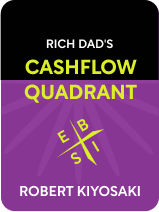

This article is an excerpt from the Shortform book guide to "Rich Dad's Cashflow Quadrant" by Robert T. Kiyosaki. Shortform has the world's best summaries and analyses of books you should be reading.
Like this article? Sign up for a free trial here .
Do you want to make a living off investing? Where do you even start?
Investing is Robert Kiyosaki’s promised land—where financial freedom really lies. Investors commit money (called capital) to something and expect to make a profit. Beyond the initial investment, they don’t have to work day to day. Instead, their livelihood comes in the form of assets that generate passive income.
Here is how to begin investing for passive income, and ultimately, wealth, according to Kiyosaki.
Step 1. Get Out of Debt
You need capital to invest, and it’s hard to have enough to spare when you’re in significant debt. (Shortform note: Kiyosaki differentiates between good debt and bad debt; sometimes going into debt is a necessary part of investing.)
Kiyosaki recommends this strategy for getting out of debt:
1. If you have credit card debt, use only one or two cards and pay off all new charges each month.
2. Earn an extra $150-$250 per month and use it to pay off one card. (Kiyosaki says if you can’t earn an extra $150 per month, the B and I categories are probably not for you.) Pay the minimum balance on all your other cards.
3. Once you pay off one card in full, move on to the others. Continue until all cards are paid.
4. Once all your credit cards are paid off, or if you don’t have credit card debt, use the same strategy with other debt, like your mortgage, car payments, or student loans.
5. Once you’re sufficiently out of debt, use the money you were putting towards your debt toward your investments.
If you don’t have debt, just put that extra $150-$250 per month toward your investments.
Step 2. Decide What Kind of Investor You Want to Be
Kiyosaki emphasizes how important it is to know how you’re going to use the I category to achieve wealth. You can use a financial advisor or learn to invest yourself as a serious side practice to generate retirement or supplemental income, or you can dedicate yourself to investing as a full-time job to “crossover” into financial freedom, where you live off your investment income.
Because you can invest with almost any amount of money, anyone can be an investor. Kiyosaki identifies three ways to use the I category:
- Retirement investing. Robert Kiyosaki doesn’t actually include people who invest only for retirement in the I category, because their investments won’t replace their income. However, because of the decline in defined-benefit retirement plans, most people invest for retirement.
- Supplemental investing. Remember, you can exist in multiple categories at the same time. You can be an E, S, or B and supplement that income with passive income from investments.
- Crossover investing. Your goal is to “cross over” to a lifestyle where you live entirely on the passive income you earn from investments. If you cross over, you front-load your work. After you research and make your investment, all you have to do is monitor your passive income to make sure it’s performing well.
Step 3. Get Started by Investing in the Stock Market and in Real Estate
Call stockbrokers and ask for their guidance, then open a small trading account. In real estate, buy, sell, and manage your own properties. No matter what you decide to invest in, learning and research are key to mitigating the risk that comes with investing.
| Ramit Sethi on Investing in the Stock Market Robert Kiyosaki’s investing advice is rather short on the specifics. In I Will Teach You to Be Rich, Sethi recommends starting with stock market investing, beginning with mutual and index funds, or, if you’re willing to sacrifice some profit for ease, investing in target-date funds. 1. Choose Your Own Portfolio Start with mutual funds and index funds. A fund is a group of many different kinds of stocks and bonds that you invest in all at once. Mutual funds are under active management, which means fund managers choose which investments to include. Mutual funds can sometimes produce great returns for a 1-2 year period, but in exchange for having a human choose your investments, you have to pay a significant amount in fees. Kiyosaki does mention mutual funds, but only to say they’re risky. Index funds are under passive management, which means an algorithm creates a fund out of a section of the stock market, like the NASDAQ, which is a technology index. In the long term, Sethi says index funds are a better investment because they have very low fees. 2. Invest in Target Date Funds Instead of managing your own portfolio of stocks, bonds, and individual funds, you can invest using target-date funds. Target date funds are funds made of funds, and recalibrate as you get closer to retirement. |

———End of Preview———
Like what you just read? Read the rest of the world's best book summary and analysis of Robert T. Kiyosaki's "Rich Dad's Cashflow Quadrant" at Shortform .
Here's what you'll find in our full Rich Dad's Cashflow Quadrant summary :
- Why the traditional path of college to career doesn't work
- Which types of income will lead you to financial freedom
- An in-depth look at Robert Kiyosaki's four cashflow quadrants






